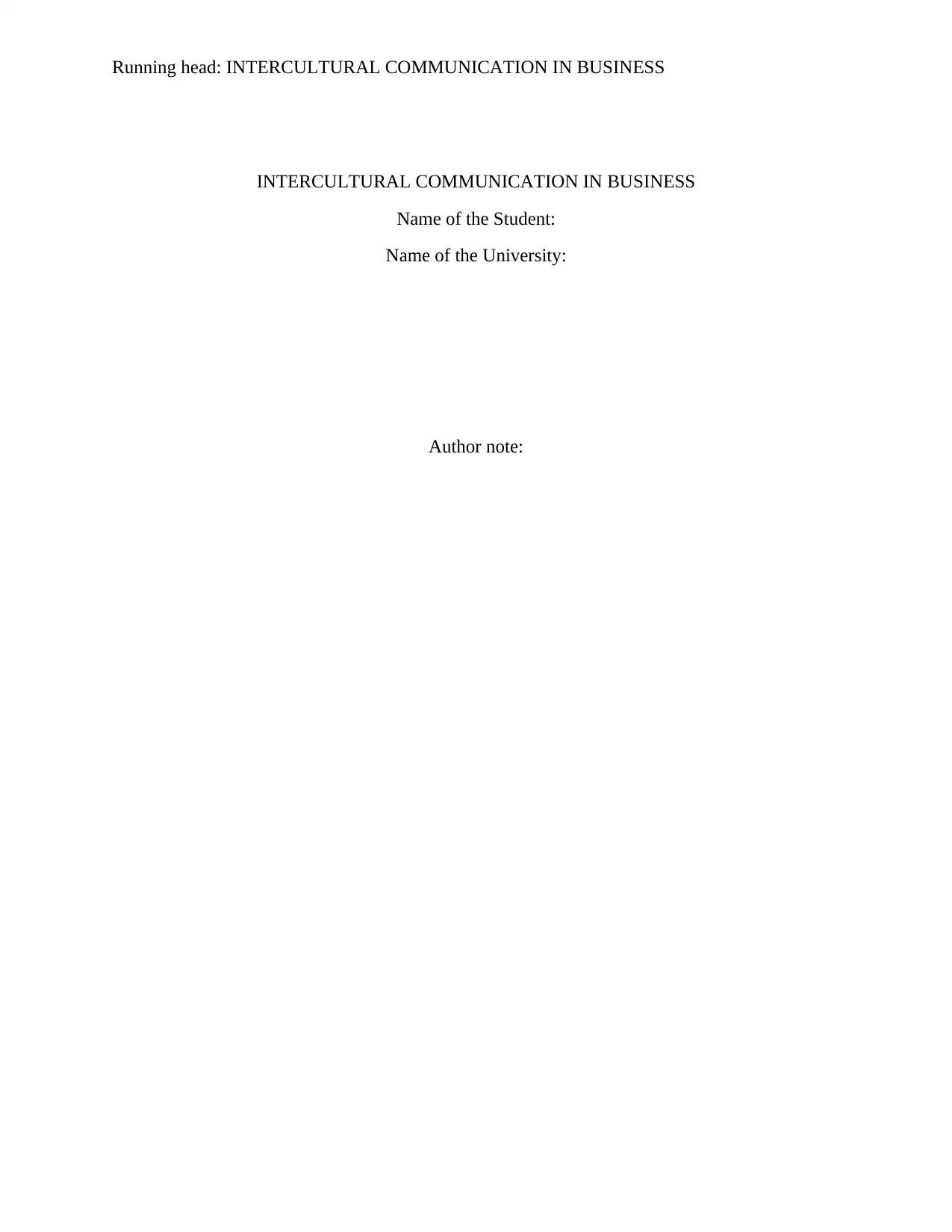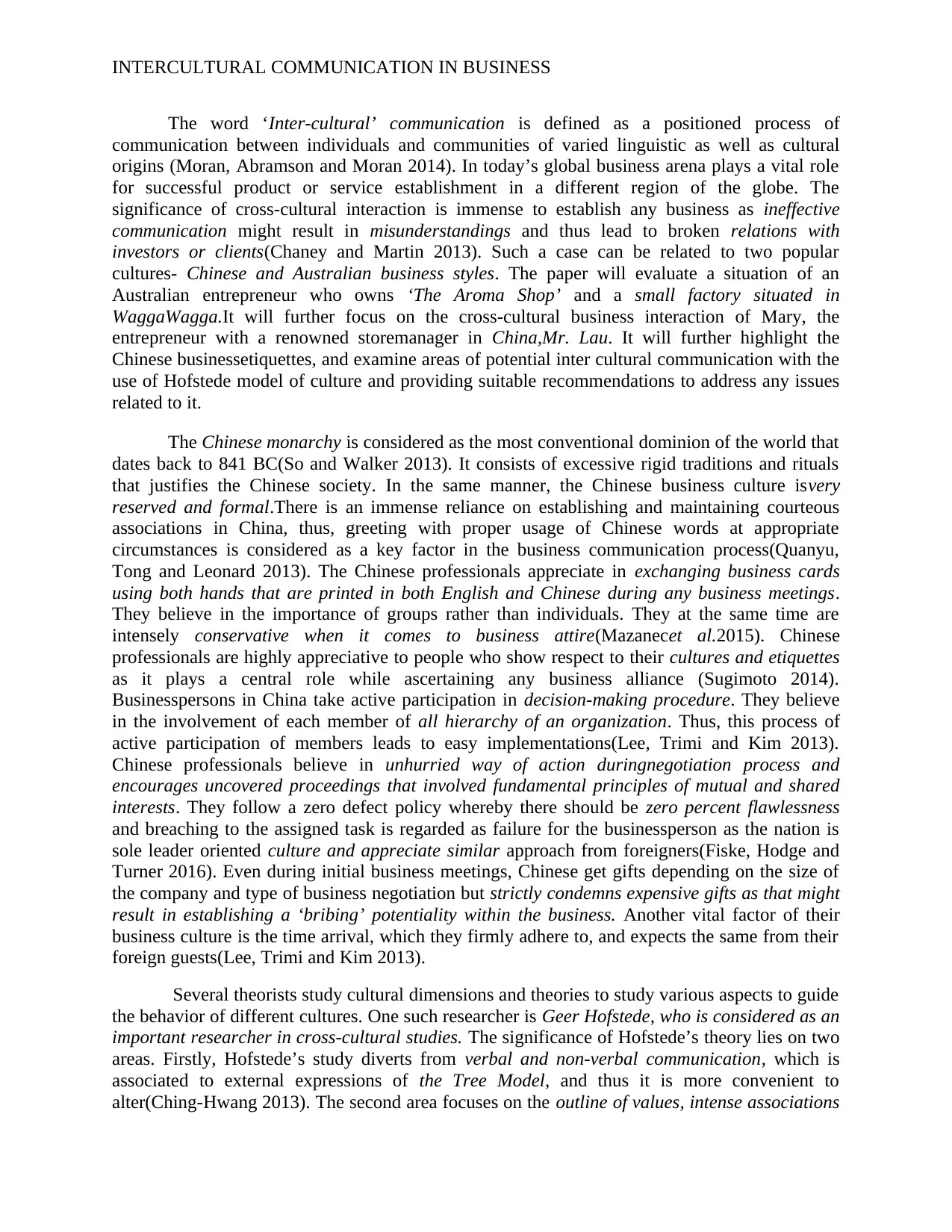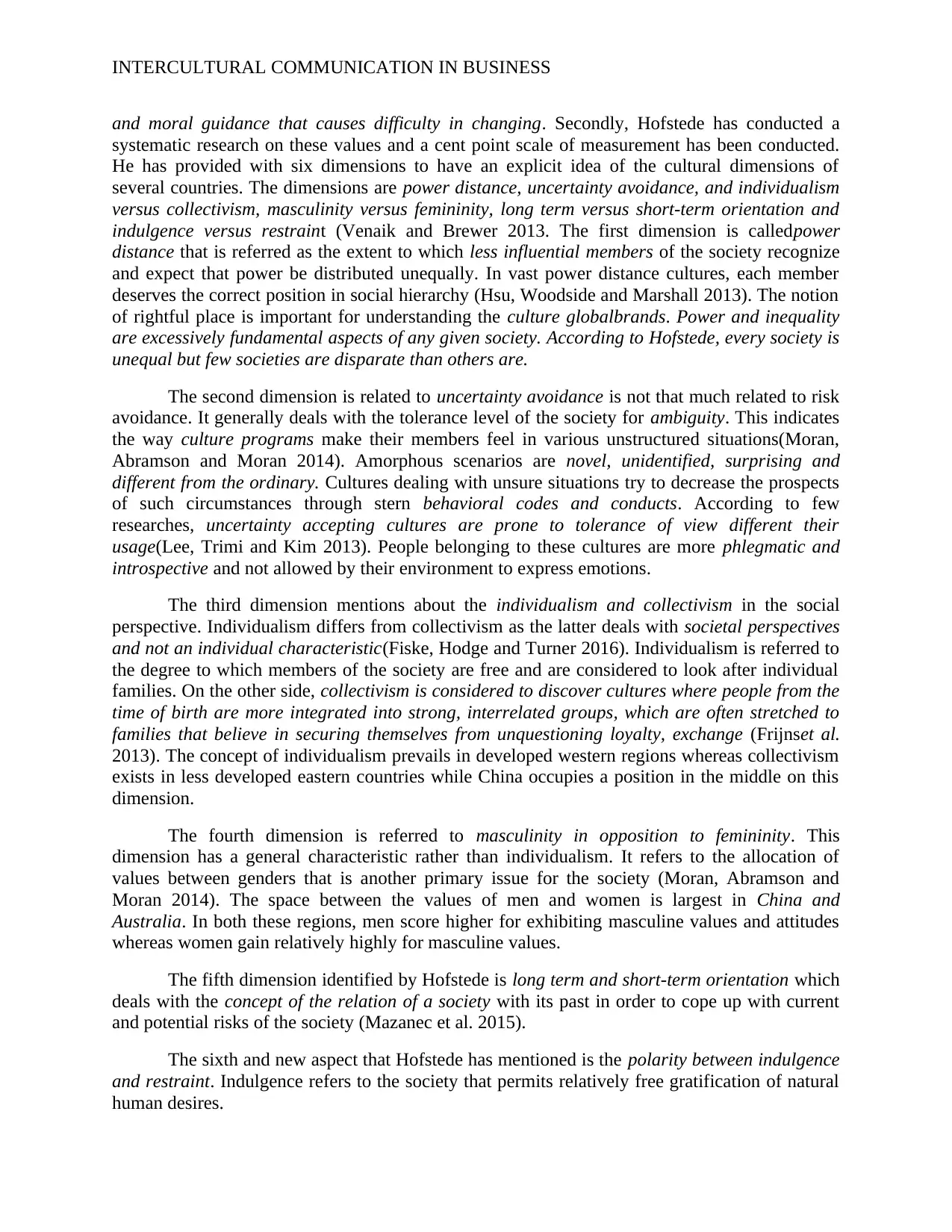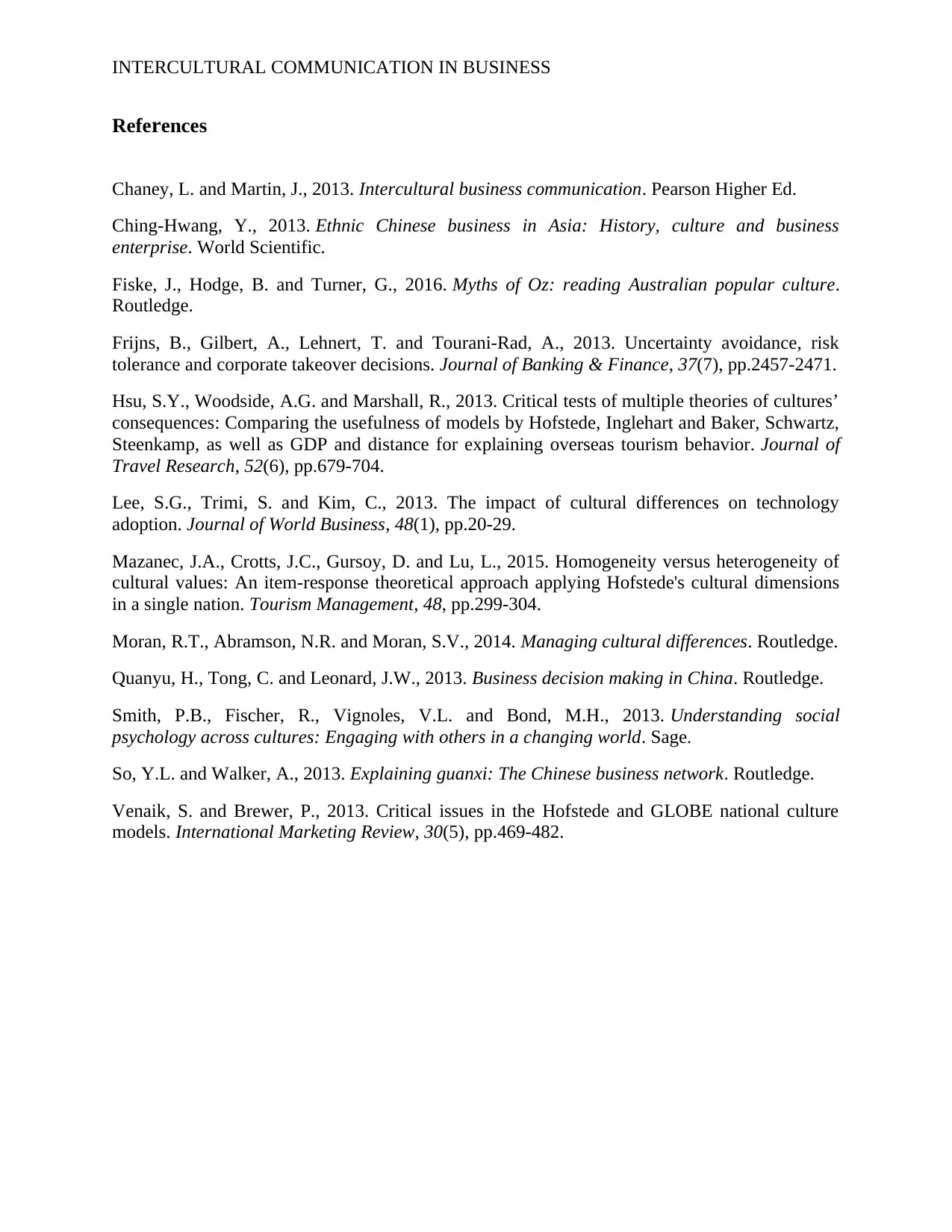The Aroma Shop: Intercultural Communication in Business in China
VerifiedAdded on 2023/06/14
|5
|2216
|242
Essay
AI Summary
This essay examines intercultural communication in the context of business, specifically focusing on a case study involving an Australian entrepreneur, Mary, and her interactions with a Chinese store manager, Mr. Lau. The paper highlights the importance of cross-cultural understanding in international business, detailing Chinese business etiquette and traditions. It applies Hofstede's cultural dimensions model to analyze potential areas of intercultural communication challenges between Australian and Chinese business styles, focusing on aspects like power distance, individualism vs. collectivism, and masculinity vs. femininity. The essay concludes with recommendations for Mary to navigate these cultural differences effectively, emphasizing the need for punctuality, respect for Chinese customs, and awareness of varying gender ideologies to ensure a successful business conversation and expansion into the Chinese market. The document is available on Desklib, a platform offering study tools and resources for students.

Running head: INTERCULTURAL COMMUNICATION IN BUSINESS
INTERCULTURAL COMMUNICATION IN BUSINESS
Name of the Student:
Name of the University:
Author note:
INTERCULTURAL COMMUNICATION IN BUSINESS
Name of the Student:
Name of the University:
Author note:
Paraphrase This Document
Need a fresh take? Get an instant paraphrase of this document with our AI Paraphraser

INTERCULTURAL COMMUNICATION IN BUSINESS
The word ‘Inter-cultural’ communication is defined as a positioned process of
communication between individuals and communities of varied linguistic as well as cultural
origins (Moran, Abramson and Moran 2014). In today’s global business arena plays a vital role
for successful product or service establishment in a different region of the globe. The
significance of cross-cultural interaction is immense to establish any business as ineffective
communication might result in misunderstandings and thus lead to broken relations with
investors or clients(Chaney and Martin 2013). Such a case can be related to two popular
cultures- Chinese and Australian business styles. The paper will evaluate a situation of an
Australian entrepreneur who owns ‘The Aroma Shop’ and a small factory situated in
WaggaWagga.It will further focus on the cross-cultural business interaction of Mary, the
entrepreneur with a renowned storemanager in China,Mr. Lau. It will further highlight the
Chinese businessetiquettes, and examine areas of potential inter cultural communication with the
use of Hofstede model of culture and providing suitable recommendations to address any issues
related to it.
The Chinese monarchy is considered as the most conventional dominion of the world that
dates back to 841 BC(So and Walker 2013). It consists of excessive rigid traditions and rituals
that justifies the Chinese society. In the same manner, the Chinese business culture isvery
reserved and formal.There is an immense reliance on establishing and maintaining courteous
associations in China, thus, greeting with proper usage of Chinese words at appropriate
circumstances is considered as a key factor in the business communication process(Quanyu,
Tong and Leonard 2013). The Chinese professionals appreciate in exchanging business cards
using both hands that are printed in both English and Chinese during any business meetings.
They believe in the importance of groups rather than individuals. They at the same time are
intensely conservative when it comes to business attire(Mazanecet al.2015). Chinese
professionals are highly appreciative to people who show respect to their cultures and etiquettes
as it plays a central role while ascertaining any business alliance (Sugimoto 2014).
Businesspersons in China take active participation in decision-making procedure. They believe
in the involvement of each member of all hierarchy of an organization. Thus, this process of
active participation of members leads to easy implementations(Lee, Trimi and Kim 2013).
Chinese professionals believe in unhurried way of action duringnegotiation process and
encourages uncovered proceedings that involved fundamental principles of mutual and shared
interests. They follow a zero defect policy whereby there should be zero percent flawlessness
and breaching to the assigned task is regarded as failure for the businessperson as the nation is
sole leader oriented culture and appreciate similar approach from foreigners(Fiske, Hodge and
Turner 2016). Even during initial business meetings, Chinese get gifts depending on the size of
the company and type of business negotiation but strictly condemns expensive gifts as that might
result in establishing a ‘bribing’ potentiality within the business. Another vital factor of their
business culture is the time arrival, which they firmly adhere to, and expects the same from their
foreign guests(Lee, Trimi and Kim 2013).
Several theorists study cultural dimensions and theories to study various aspects to guide
the behavior of different cultures. One such researcher is Geer Hofstede, who is considered as an
important researcher in cross-cultural studies. The significance of Hofstede’s theory lies on two
areas. Firstly, Hofstede’s study diverts from verbal and non-verbal communication, which is
associated to external expressions of the Tree Model, and thus it is more convenient to
alter(Ching-Hwang 2013). The second area focuses on the outline of values, intense associations
The word ‘Inter-cultural’ communication is defined as a positioned process of
communication between individuals and communities of varied linguistic as well as cultural
origins (Moran, Abramson and Moran 2014). In today’s global business arena plays a vital role
for successful product or service establishment in a different region of the globe. The
significance of cross-cultural interaction is immense to establish any business as ineffective
communication might result in misunderstandings and thus lead to broken relations with
investors or clients(Chaney and Martin 2013). Such a case can be related to two popular
cultures- Chinese and Australian business styles. The paper will evaluate a situation of an
Australian entrepreneur who owns ‘The Aroma Shop’ and a small factory situated in
WaggaWagga.It will further focus on the cross-cultural business interaction of Mary, the
entrepreneur with a renowned storemanager in China,Mr. Lau. It will further highlight the
Chinese businessetiquettes, and examine areas of potential inter cultural communication with the
use of Hofstede model of culture and providing suitable recommendations to address any issues
related to it.
The Chinese monarchy is considered as the most conventional dominion of the world that
dates back to 841 BC(So and Walker 2013). It consists of excessive rigid traditions and rituals
that justifies the Chinese society. In the same manner, the Chinese business culture isvery
reserved and formal.There is an immense reliance on establishing and maintaining courteous
associations in China, thus, greeting with proper usage of Chinese words at appropriate
circumstances is considered as a key factor in the business communication process(Quanyu,
Tong and Leonard 2013). The Chinese professionals appreciate in exchanging business cards
using both hands that are printed in both English and Chinese during any business meetings.
They believe in the importance of groups rather than individuals. They at the same time are
intensely conservative when it comes to business attire(Mazanecet al.2015). Chinese
professionals are highly appreciative to people who show respect to their cultures and etiquettes
as it plays a central role while ascertaining any business alliance (Sugimoto 2014).
Businesspersons in China take active participation in decision-making procedure. They believe
in the involvement of each member of all hierarchy of an organization. Thus, this process of
active participation of members leads to easy implementations(Lee, Trimi and Kim 2013).
Chinese professionals believe in unhurried way of action duringnegotiation process and
encourages uncovered proceedings that involved fundamental principles of mutual and shared
interests. They follow a zero defect policy whereby there should be zero percent flawlessness
and breaching to the assigned task is regarded as failure for the businessperson as the nation is
sole leader oriented culture and appreciate similar approach from foreigners(Fiske, Hodge and
Turner 2016). Even during initial business meetings, Chinese get gifts depending on the size of
the company and type of business negotiation but strictly condemns expensive gifts as that might
result in establishing a ‘bribing’ potentiality within the business. Another vital factor of their
business culture is the time arrival, which they firmly adhere to, and expects the same from their
foreign guests(Lee, Trimi and Kim 2013).
Several theorists study cultural dimensions and theories to study various aspects to guide
the behavior of different cultures. One such researcher is Geer Hofstede, who is considered as an
important researcher in cross-cultural studies. The significance of Hofstede’s theory lies on two
areas. Firstly, Hofstede’s study diverts from verbal and non-verbal communication, which is
associated to external expressions of the Tree Model, and thus it is more convenient to
alter(Ching-Hwang 2013). The second area focuses on the outline of values, intense associations

INTERCULTURAL COMMUNICATION IN BUSINESS
and moral guidance that causes difficulty in changing. Secondly, Hofstede has conducted a
systematic research on these values and a cent point scale of measurement has been conducted.
He has provided with six dimensions to have an explicit idea of the cultural dimensions of
several countries. The dimensions are power distance, uncertainty avoidance, and individualism
versus collectivism, masculinity versus femininity, long term versus short-term orientation and
indulgence versus restraint (Venaik and Brewer 2013. The first dimension is calledpower
distance that is referred as the extent to which less influential members of the society recognize
and expect that power be distributed unequally. In vast power distance cultures, each member
deserves the correct position in social hierarchy (Hsu, Woodside and Marshall 2013). The notion
of rightful place is important for understanding the culture globalbrands. Power and inequality
are excessively fundamental aspects of any given society. According to Hofstede, every society is
unequal but few societies are disparate than others are.
The second dimension is related to uncertainty avoidance is not that much related to risk
avoidance. It generally deals with the tolerance level of the society for ambiguity. This indicates
the way culture programs make their members feel in various unstructured situations(Moran,
Abramson and Moran 2014). Amorphous scenarios are novel, unidentified, surprising and
different from the ordinary. Cultures dealing with unsure situations try to decrease the prospects
of such circumstances through stern behavioral codes and conducts. According to few
researches, uncertainty accepting cultures are prone to tolerance of view different their
usage(Lee, Trimi and Kim 2013). People belonging to these cultures are more phlegmatic and
introspective and not allowed by their environment to express emotions.
The third dimension mentions about the individualism and collectivism in the social
perspective. Individualism differs from collectivism as the latter deals with societal perspectives
and not an individual characteristic(Fiske, Hodge and Turner 2016). Individualism is referred to
the degree to which members of the society are free and are considered to look after individual
families. On the other side, collectivism is considered to discover cultures where people from the
time of birth are more integrated into strong, interrelated groups, which are often stretched to
families that believe in securing themselves from unquestioning loyalty, exchange (Frijnset al.
2013). The concept of individualism prevails in developed western regions whereas collectivism
exists in less developed eastern countries while China occupies a position in the middle on this
dimension.
The fourth dimension is referred to masculinity in opposition to femininity. This
dimension has a general characteristic rather than individualism. It refers to the allocation of
values between genders that is another primary issue for the society (Moran, Abramson and
Moran 2014). The space between the values of men and women is largest in China and
Australia. In both these regions, men score higher for exhibiting masculine values and attitudes
whereas women gain relatively highly for masculine values.
The fifth dimension identified by Hofstede is long term and short-term orientation which
deals with the concept of the relation of a society with its past in order to cope up with current
and potential risks of the society (Mazanec et al. 2015).
The sixth and new aspect that Hofstede has mentioned is the polarity between indulgence
and restraint. Indulgence refers to the society that permits relatively free gratification of natural
human desires.
and moral guidance that causes difficulty in changing. Secondly, Hofstede has conducted a
systematic research on these values and a cent point scale of measurement has been conducted.
He has provided with six dimensions to have an explicit idea of the cultural dimensions of
several countries. The dimensions are power distance, uncertainty avoidance, and individualism
versus collectivism, masculinity versus femininity, long term versus short-term orientation and
indulgence versus restraint (Venaik and Brewer 2013. The first dimension is calledpower
distance that is referred as the extent to which less influential members of the society recognize
and expect that power be distributed unequally. In vast power distance cultures, each member
deserves the correct position in social hierarchy (Hsu, Woodside and Marshall 2013). The notion
of rightful place is important for understanding the culture globalbrands. Power and inequality
are excessively fundamental aspects of any given society. According to Hofstede, every society is
unequal but few societies are disparate than others are.
The second dimension is related to uncertainty avoidance is not that much related to risk
avoidance. It generally deals with the tolerance level of the society for ambiguity. This indicates
the way culture programs make their members feel in various unstructured situations(Moran,
Abramson and Moran 2014). Amorphous scenarios are novel, unidentified, surprising and
different from the ordinary. Cultures dealing with unsure situations try to decrease the prospects
of such circumstances through stern behavioral codes and conducts. According to few
researches, uncertainty accepting cultures are prone to tolerance of view different their
usage(Lee, Trimi and Kim 2013). People belonging to these cultures are more phlegmatic and
introspective and not allowed by their environment to express emotions.
The third dimension mentions about the individualism and collectivism in the social
perspective. Individualism differs from collectivism as the latter deals with societal perspectives
and not an individual characteristic(Fiske, Hodge and Turner 2016). Individualism is referred to
the degree to which members of the society are free and are considered to look after individual
families. On the other side, collectivism is considered to discover cultures where people from the
time of birth are more integrated into strong, interrelated groups, which are often stretched to
families that believe in securing themselves from unquestioning loyalty, exchange (Frijnset al.
2013). The concept of individualism prevails in developed western regions whereas collectivism
exists in less developed eastern countries while China occupies a position in the middle on this
dimension.
The fourth dimension is referred to masculinity in opposition to femininity. This
dimension has a general characteristic rather than individualism. It refers to the allocation of
values between genders that is another primary issue for the society (Moran, Abramson and
Moran 2014). The space between the values of men and women is largest in China and
Australia. In both these regions, men score higher for exhibiting masculine values and attitudes
whereas women gain relatively highly for masculine values.
The fifth dimension identified by Hofstede is long term and short-term orientation which
deals with the concept of the relation of a society with its past in order to cope up with current
and potential risks of the society (Mazanec et al. 2015).
The sixth and new aspect that Hofstede has mentioned is the polarity between indulgence
and restraint. Indulgence refers to the society that permits relatively free gratification of natural
human desires.
⊘ This is a preview!⊘
Do you want full access?
Subscribe today to unlock all pages.

Trusted by 1+ million students worldwide

INTERCULTURAL COMMUNICATION IN BUSINESS
According to Hofstede’s power distance, the power distance in Australia is considered
relatively low and specifies to greater range of equality between societal levels such as
government and social organizations (Lee, Trimi and Kim 2013). On the other hand, Chinese
power distance has high rate of power distance that results in members of an organization to
possess greater power and authority than the others. They generalize the notion of status and
power with a section of the society considered as superior because of their social status, gender
and race than the others who have not advantageous enough to receive such ascribed status
(Smith et al. 2013). A high level of individualismis also noticed in the Australian culture whereas
China shows a high level of collectivism and group orientation in their culture. The latter
emphasizes a very strong group harmony and interdependence(Fiske, Hodge and Turner 2016).
Hofstede’s dimensions on cultural difference also focus on the masculinity and femininity
dimension on the role dissemination between genders. The masculinity dimension is higher in
China than Australia, as Australia reflects cultural assertiveness, material success, confidence
and individual accomplishments (Fiske, Hodge and Turner 2016). Australia is regarded as a
universalistic culture where agreements and contracts are based on the terms of business and
laws are applied to every citizen of the country whereas China reflects something dissimilar from
the former.
A set of recommendationsmust be provided for an effective business meeting between
Mary and Mr. Lau. Mary, belonging from a Western country must honor the value of time as
Chinese have an excessive ability of punctuality. Chinese believe in silence at a business setting
and consider it as a key to wisdom and self-control. Thus, Mary shall not indulge in speaking
excess and giving excess of information as this might hinder the meeting. Furthermore, Mary
must consider the masculinity aspect of the Chinese. Thus, Mary, in order to conduct a smooth
conversation with Mr. Lau must keep in mind the varying ideologies of men in China and her
own country. Lastly, she needs to honor Chinese culture and avoid any miscommunication
related to the cultural disparity between the two countries.
Therefore, from the above discussion it can be analyzed that a wide gap lies between the
cultural dimensions of Australia and China. This essay has evaluated the cultural traditions and
business etiquettes that Chinese business professionals follow to establish successful and
effective businesses. It also focused on the cultural framework through Hofstede’s cultural
framework to understand various cultural aspects. Lastly, this paper explored cultural
discrepancies of China and Australia and further provided recommendations that will be
beneficial for the Australian businessperson Mary to conduct an effective business conversation
with Mr. Lau for her business expansion in China.
According to Hofstede’s power distance, the power distance in Australia is considered
relatively low and specifies to greater range of equality between societal levels such as
government and social organizations (Lee, Trimi and Kim 2013). On the other hand, Chinese
power distance has high rate of power distance that results in members of an organization to
possess greater power and authority than the others. They generalize the notion of status and
power with a section of the society considered as superior because of their social status, gender
and race than the others who have not advantageous enough to receive such ascribed status
(Smith et al. 2013). A high level of individualismis also noticed in the Australian culture whereas
China shows a high level of collectivism and group orientation in their culture. The latter
emphasizes a very strong group harmony and interdependence(Fiske, Hodge and Turner 2016).
Hofstede’s dimensions on cultural difference also focus on the masculinity and femininity
dimension on the role dissemination between genders. The masculinity dimension is higher in
China than Australia, as Australia reflects cultural assertiveness, material success, confidence
and individual accomplishments (Fiske, Hodge and Turner 2016). Australia is regarded as a
universalistic culture where agreements and contracts are based on the terms of business and
laws are applied to every citizen of the country whereas China reflects something dissimilar from
the former.
A set of recommendationsmust be provided for an effective business meeting between
Mary and Mr. Lau. Mary, belonging from a Western country must honor the value of time as
Chinese have an excessive ability of punctuality. Chinese believe in silence at a business setting
and consider it as a key to wisdom and self-control. Thus, Mary shall not indulge in speaking
excess and giving excess of information as this might hinder the meeting. Furthermore, Mary
must consider the masculinity aspect of the Chinese. Thus, Mary, in order to conduct a smooth
conversation with Mr. Lau must keep in mind the varying ideologies of men in China and her
own country. Lastly, she needs to honor Chinese culture and avoid any miscommunication
related to the cultural disparity between the two countries.
Therefore, from the above discussion it can be analyzed that a wide gap lies between the
cultural dimensions of Australia and China. This essay has evaluated the cultural traditions and
business etiquettes that Chinese business professionals follow to establish successful and
effective businesses. It also focused on the cultural framework through Hofstede’s cultural
framework to understand various cultural aspects. Lastly, this paper explored cultural
discrepancies of China and Australia and further provided recommendations that will be
beneficial for the Australian businessperson Mary to conduct an effective business conversation
with Mr. Lau for her business expansion in China.
Paraphrase This Document
Need a fresh take? Get an instant paraphrase of this document with our AI Paraphraser

INTERCULTURAL COMMUNICATION IN BUSINESS
References
Chaney, L. and Martin, J., 2013. Intercultural business communication. Pearson Higher Ed.
Ching-Hwang, Y., 2013. Ethnic Chinese business in Asia: History, culture and business
enterprise. World Scientific.
Fiske, J., Hodge, B. and Turner, G., 2016. Myths of Oz: reading Australian popular culture.
Routledge.
Frijns, B., Gilbert, A., Lehnert, T. and Tourani-Rad, A., 2013. Uncertainty avoidance, risk
tolerance and corporate takeover decisions. Journal of Banking & Finance, 37(7), pp.2457-2471.
Hsu, S.Y., Woodside, A.G. and Marshall, R., 2013. Critical tests of multiple theories of cultures’
consequences: Comparing the usefulness of models by Hofstede, Inglehart and Baker, Schwartz,
Steenkamp, as well as GDP and distance for explaining overseas tourism behavior. Journal of
Travel Research, 52(6), pp.679-704.
Lee, S.G., Trimi, S. and Kim, C., 2013. The impact of cultural differences on technology
adoption. Journal of World Business, 48(1), pp.20-29.
Mazanec, J.A., Crotts, J.C., Gursoy, D. and Lu, L., 2015. Homogeneity versus heterogeneity of
cultural values: An item-response theoretical approach applying Hofstede's cultural dimensions
in a single nation. Tourism Management, 48, pp.299-304.
Moran, R.T., Abramson, N.R. and Moran, S.V., 2014. Managing cultural differences. Routledge.
Quanyu, H., Tong, C. and Leonard, J.W., 2013. Business decision making in China. Routledge.
Smith, P.B., Fischer, R., Vignoles, V.L. and Bond, M.H., 2013. Understanding social
psychology across cultures: Engaging with others in a changing world. Sage.
So, Y.L. and Walker, A., 2013. Explaining guanxi: The Chinese business network. Routledge.
Venaik, S. and Brewer, P., 2013. Critical issues in the Hofstede and GLOBE national culture
models. International Marketing Review, 30(5), pp.469-482.
References
Chaney, L. and Martin, J., 2013. Intercultural business communication. Pearson Higher Ed.
Ching-Hwang, Y., 2013. Ethnic Chinese business in Asia: History, culture and business
enterprise. World Scientific.
Fiske, J., Hodge, B. and Turner, G., 2016. Myths of Oz: reading Australian popular culture.
Routledge.
Frijns, B., Gilbert, A., Lehnert, T. and Tourani-Rad, A., 2013. Uncertainty avoidance, risk
tolerance and corporate takeover decisions. Journal of Banking & Finance, 37(7), pp.2457-2471.
Hsu, S.Y., Woodside, A.G. and Marshall, R., 2013. Critical tests of multiple theories of cultures’
consequences: Comparing the usefulness of models by Hofstede, Inglehart and Baker, Schwartz,
Steenkamp, as well as GDP and distance for explaining overseas tourism behavior. Journal of
Travel Research, 52(6), pp.679-704.
Lee, S.G., Trimi, S. and Kim, C., 2013. The impact of cultural differences on technology
adoption. Journal of World Business, 48(1), pp.20-29.
Mazanec, J.A., Crotts, J.C., Gursoy, D. and Lu, L., 2015. Homogeneity versus heterogeneity of
cultural values: An item-response theoretical approach applying Hofstede's cultural dimensions
in a single nation. Tourism Management, 48, pp.299-304.
Moran, R.T., Abramson, N.R. and Moran, S.V., 2014. Managing cultural differences. Routledge.
Quanyu, H., Tong, C. and Leonard, J.W., 2013. Business decision making in China. Routledge.
Smith, P.B., Fischer, R., Vignoles, V.L. and Bond, M.H., 2013. Understanding social
psychology across cultures: Engaging with others in a changing world. Sage.
So, Y.L. and Walker, A., 2013. Explaining guanxi: The Chinese business network. Routledge.
Venaik, S. and Brewer, P., 2013. Critical issues in the Hofstede and GLOBE national culture
models. International Marketing Review, 30(5), pp.469-482.
1 out of 5
Your All-in-One AI-Powered Toolkit for Academic Success.
+13062052269
info@desklib.com
Available 24*7 on WhatsApp / Email
![[object Object]](/_next/static/media/star-bottom.7253800d.svg)
Unlock your academic potential
Copyright © 2020–2025 A2Z Services. All Rights Reserved. Developed and managed by ZUCOL.

